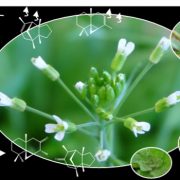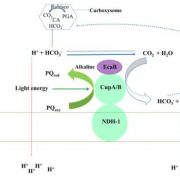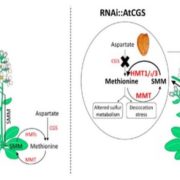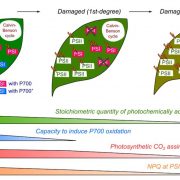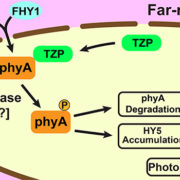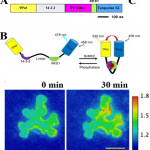Natural variations at the Stay-Green gene promoter control lifespan and yield in rice cultivars (Nature Comms)
 Crop production is greatly influenced by the duration of the last stage of plant life cycle, senescence, through degradation of resources in leaves and remobilization of nutrients to developing seeds. Indeed, higher grain yield of important cereals such as maize and sorghum can be achieved by using stay-green (sgr) mutants characterized by delayed senescence. Nevertheless, this agronomical trait has not been fully explored in Asian rice (O. sativa). In this article, Shin and colleagues investigated the genetic basis of senescence by crossing cultivars belonging to the subspecies japonica and indica, which show similar heading dates but different lifespans. QTL mapping revealed that differential senescence correlated with variations in the promoter region of the OsSGR gene, encoding an enzyme involved in chlorophyll catabolism. Polymorphisms in the indica allele associated with earlier activation and higher expression of OsSGR, leading to a faster chlorophyll breakdown, reduced photosynthetic ability and decreased yield. Further analyses suggested that senescence patterns of rice varieties have been selected on the basis of the growing areas and cultivation practices: indica cultivars are better suited for tropical regions with double or triple cropping systems, whereas japonica cultivars are better suited for temperate and subtropical regions with a single harvesting system. Last, the authors generated Near Isogenic Lines (NIL) carrying the japonica OsSGR alleles in indica genetic background, and observed delayed senescence and an average 10% increase in grain yield. These findings indicate that prolonged photosynthetic ability and higher chlorophyll content can improve grain filling and crop production. (Summary by Michela Osnato @michela_osnato) Nature Comms. 10.1038/s41467-020-16573-2
Crop production is greatly influenced by the duration of the last stage of plant life cycle, senescence, through degradation of resources in leaves and remobilization of nutrients to developing seeds. Indeed, higher grain yield of important cereals such as maize and sorghum can be achieved by using stay-green (sgr) mutants characterized by delayed senescence. Nevertheless, this agronomical trait has not been fully explored in Asian rice (O. sativa). In this article, Shin and colleagues investigated the genetic basis of senescence by crossing cultivars belonging to the subspecies japonica and indica, which show similar heading dates but different lifespans. QTL mapping revealed that differential senescence correlated with variations in the promoter region of the OsSGR gene, encoding an enzyme involved in chlorophyll catabolism. Polymorphisms in the indica allele associated with earlier activation and higher expression of OsSGR, leading to a faster chlorophyll breakdown, reduced photosynthetic ability and decreased yield. Further analyses suggested that senescence patterns of rice varieties have been selected on the basis of the growing areas and cultivation practices: indica cultivars are better suited for tropical regions with double or triple cropping systems, whereas japonica cultivars are better suited for temperate and subtropical regions with a single harvesting system. Last, the authors generated Near Isogenic Lines (NIL) carrying the japonica OsSGR alleles in indica genetic background, and observed delayed senescence and an average 10% increase in grain yield. These findings indicate that prolonged photosynthetic ability and higher chlorophyll content can improve grain filling and crop production. (Summary by Michela Osnato @michela_osnato) Nature Comms. 10.1038/s41467-020-16573-2


